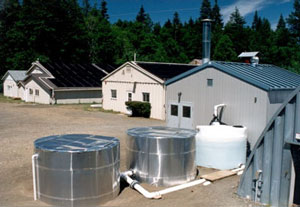solar hot water for aquaculture

Solar energy in the aguacultural industry (Rosewall Creek). Photo credit: Natural Resources Canada.
Fish grow faster in warmer water, therefore to increase production yields fish hatcheries often have systems to heat the water delivered to the fish. Heating can account for a substantial portion of the expenses for an aquacultural facility, especially since these facilities often do not have access to cheaper natural gas. Solar water heating for the aquaculture of salmon, trout, and tilapia has been investigated, each fish having different water temperature requirements. Simple payback terms as low as 5 years have been found.
For salmon and trout hatcheries the delivered water is usually ground water and is typically heated from 8–9°C to 14–15°C. Unglazed flat plate collectors operate efficiently at these low temperatures and have a low capital cost, therefore they are preferred over other liquid-based collectors for this application. These low temperatures are so advantageous for efficient operation of the solar collectors that the water can even be heated during the night when the air temperature is high. These systems pass the water once through and heat is recaptured from the effluent via a large parallel plate heat exchanger. Thermal storage is recommended so that heated water can be provided during the night and on cloudy days.
An auxiliary heating system is not necessarily required with trout hatcheries because trout can easily handle a fluctuating temperature between 8°C and 15°C. It is, however, necessary for salmon.
